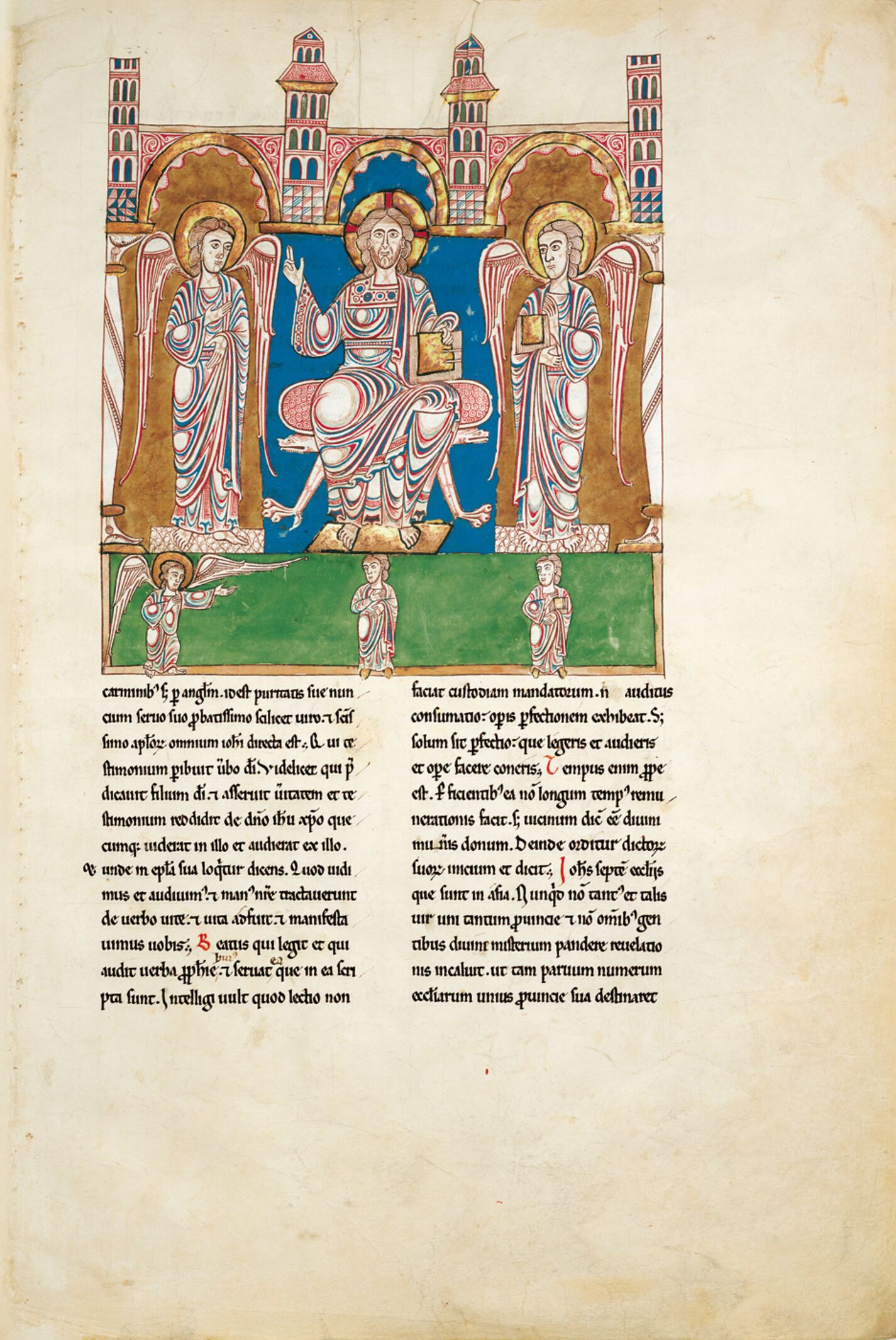This is the first illustration by master B, the design of which is very deficient. Unlike the Fernando I and Gerona Beatus in which the two parts of the scene are of a similar size, here special emphasis is given to the representation of Christ at the top of the folio on his throne flanked by two angels, relegating the other three figures to the bottom with very small dimensions. Christ holds a closed book in his hands and has already given the book of the Revelation to one angel whilst the other looks on from one side. At the bottom, the angel has given the book to John whilst another figure looks on. John keeps the last book of the Bible closed unlike in previous Beatus, which may suggest that the illuminator was unaware of the meaning of the illustration. The person by his side could be identified, as J. Yarza suggests in the Fernando I Beatus, as Prochoros or Procoro, one of the seven men mentioned in the Acts of the Apostles, and featured in Byzantine but not western art. The angel situated behind Christ is not mentioned in the text and was added to highlight Christ’s grandeur. The throne is very historiated and features snakes whose heads extend sideways and sturdy, prehensile legs. Christ is seated upon a thick cushion. The scene is set inside a church with three naves and slightly banked Roman arches lobed on the inside, separated by four towers reproduced in the churches to whom the messages were addressed. In fact they would seem to be a reference to them. The division into bands of plain colours, with green below and blue above to represent the sky, persists. Nimbi, arches and annulets on the capitals and bases brim with gold and create a particularly lavish illustration. The remarkable similarity between this illustration and the one in the Manchester Beatus (f. 25v) again reinforces the idea that it was modelled on the Cardeña Beatus. Only the architectural element that frames the scene in the model is missing.
Ángela Franco Mata
Chief of the Medieval Antiquities Department, Museo Arqueológico Nacional
(Fragment of the Cardeña Beatus commentary volume)

This is the first illustration by master B, the design of which is very deficient. Unlike the Fernando I and Gerona Beatus in which the two parts of the scene are of a similar size, here special emphasis is given to the representation of Christ at the top of the folio on his throne flanked by two angels, relegating the other three figures to the bottom with very small dimensions. Christ holds a closed book in his hands and has already given the book of the Revelation to one angel whilst the other looks on from one side. At the bottom, the angel has given the book to John whilst another figure looks on. John keeps the last book of the Bible closed unlike in previous Beatus, which may suggest that the illuminator was unaware of the meaning of the illustration. The person by his side could be identified, as J. Yarza suggests in the Fernando I Beatus, as Prochoros or Procoro, one of the seven men mentioned in the Acts of the Apostles, and featured in Byzantine but not western art. The angel situated behind Christ is not mentioned in the text and was added to highlight Christ’s grandeur. The throne is very historiated and features snakes whose heads extend sideways and sturdy, prehensile legs. Christ is seated upon a thick cushion. The scene is set inside a church with three naves and slightly banked Roman arches lobed on the inside, separated by four towers reproduced in the churches to whom the messages were addressed. In fact they would seem to be a reference to them. The division into bands of plain colours, with green below and blue above to represent the sky, persists. Nimbi, arches and annulets on the capitals and bases brim with gold and create a particularly lavish illustration. The remarkable similarity between this illustration and the one in the Manchester Beatus (f. 25v) again reinforces the idea that it was modelled on the Cardeña Beatus. Only the architectural element that frames the scene in the model is missing.
Ángela Franco Mata
Chief of the Medieval Antiquities Department, Museo Arqueológico Nacional
(Fragment of the Cardeña Beatus commentary volume)